Nothing is more important to your safety while climbing than being able to trust your belayer. When choosing a belay device.
There are lots of different Belay devices on the market, but how do you know which one is the best Belay device for your needs? Belay devices are essential to belaying and rappelling on climbing ropes.
They help increase safety by preventing a fall from turning into a deadly one, and they can help smooth out a potentially jerky descent. Even if you’re experienced in climbing equipment and techniques, it’s worth getting acquainted with the different types of belay devices available before choosing one to add to your gear collection.
We’ve compiled some of the best belay devices on the market and created a simple chart so you can find your perfect device.
Table of Contents
Best Belay Devices for Climbing
Petzl GriGri
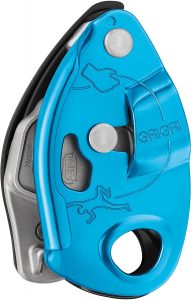
The Petzl GRIGRI is a belay device with an assisted braking system that’s designed to be used with single ropes from 8.5 to 11 mm in diameter. The GRIGRI features a camming mechanism with a 3:1 mechanical advantage, which provides smooth rope control and reduces lowering efforts regardless of rope diameter. The cam locks automatically when the climber falls or weights the rope, allowing the belayer to concentrate on maintaining a good stance and keeping control of the situation.
The GRIGRI is simple to use for belaying both lead and top-rope climbers and comes with a built-in safety catch for the event of accidental release. The rope installation diagram engraved on the inside and outside of the device serves as a friendly reminder to novices and experts alike, while also making it easy to see how much rope is being taken up in each position.
The GRIGRI’s durable construction makes it suitable for frequent use, while its ergonomic handle allows belayers to easily unblock the rope and lower someone (the lever is located below the handle). The device can be locked in either direction using a simple switch on its side; this feature gives you flexibility when belaying different types of climbers (e.g., sport climbers might prefer their bel
SPECS:
Weight: 175 g
Rope Compatibility: 8.5 to 11 mm single rope
Material(s): Aluminum side plates, stainless steel cam, friction plate, reinforced nylon handle
What we like:
- Durable, compact, and lightweight (175 grams).
- Compatible with 8.5 to 11 mm dynamic single ropes.
- Simple to use for belaying both lead and top-rope climbers.
- The mechanical advantage of the camming mechanism.
- Smoothly control the rope.
- Reduce lowering efforts regardless of rope diameter.
- Cam-assisted blocking ensures a comfortable belay.
- The cam in the device automatically cinches down to arrest the rope.
- The rope installation diagram engraved on the inside and outside of the device serves as a friendly reminder to novices and experts alike.
- An ergonomic handle allows the belayer to unblock the rope and lower someone easily.
Petzl GriGri 2
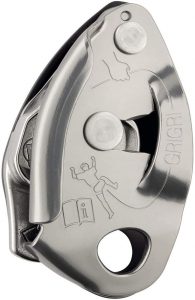
The GRIGRI 2 belay device with assisted braking capability is designed to facilitate belay maneuvers.
The GRIGRI 2 works equally well for lead climbing and top-roping. It may be used on all single dynamic 8.9 to 11 mm ropes on the market. Both compact and ultra-light, this device can be used for any type of climbing: indoor or outdoor, sport or trad, big wall or winter climbing.
The GRIGRI 2 has a new design that allows excellent control during the descent. One hand holds the rope and the other uses the handle to unlock the cam. This system does not require pressure from both hands like other assisted braking devices on the market (AAD). The belayer remains in control of the situation at all times, even during difficult maneuvers.
The Belay technique is identical to classic Belay systems: both hands on the rope. A fall is stopped by tightening the hand on the free end of the rope Assisted braking.
The patented handle design allows a very gradual release of the rope. In combination with the strong braking action of the cam, this technique offers great safety in case of a fall while rappelling or lowering someone
SPECS:
Weight: 170 g
Rope compatibility: For use with single ropes between 8.9 and 11 mm in diameter
Material(s): aluminum side plates, stainless steel cam, friction plate, reinforced nylon handle
What we like:
- Petzl – GRIGRI 2 Belay device with assisted braking for 8.9 to 11 mm rope.
- The GRIGRI 2 belay device with assisted braking capability is designed to facilitate belay maneuvers.
- The GRIGRI 2 works equally well for lead climbing and top-roping. It may be used on all single dynamic 8.9 to 11 mm ropes on the market. Both compact and ultra-light,
- The GRIGRI 2 has a new design that allows excellent control during the descent. One hand holds the rope and the other uses the handle to unlock the cam.
- The Belay technique is identical to classic Belay systems: both hands on the rope. A fall is stopped by tightening the hand on the free end of the rope Assisted braking.
- The patented handle design allows a very gradual release of the rope. In combination with the strong braking action of the cam.
- The GRIGRI 2 is compact and ultra-light at 170 g Built with a stainless steel friction plate and cam to ensure a long life for the product For 8.9 to 11 mm single ropes Diagrams
Petzl GriGri+
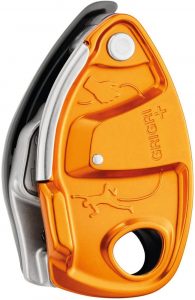
The Petzl GRIGRI is the gold standard for belay devices. It has a unique handle design that allows for the effortless and safe lowering of your climber. The 3:1 mechanical advantage of the camming mechanism helps smoothly control the rope and reduces lowering efforts regardless of rope diameter.
The cam-assisted blocking ensures a comfortable belay—when the climber falls or weights the rope—the cam in the device automatically cinches down to arrest the rope. Compatible with 8.5 to 11 mm dynamic single ropes.
If the user pulls too hard on the handle, the anti-panic function engages, stopping the climber’s descent. Great for newer belayers and partners with large weight differences.
The lockable selector knob allows you to choose either top rope or lead belay mode. Top rope belay mode makes taking in slack easier and long belay sessions more comfortable. The stainless steel wear plate provides extra protection for the high-wear area on the GRIGRI (near the brake side of the rope).
SPECS:
Weight: 200 g
Rope Compatibility: 8.5 to 11 mm single rope
Material(s): Aluminum side plates, stainless steel friction plate, cam, and wear plate, reinforced nylon handle
What we like:
- A unique handle design that allows for effortless and safe lowering of your climber.
- The 3:1 mechanical advantage of the camming mechanism helps smoothly control the rope and reduces lowering efforts regardless of rope diameter.
- The cam-assisted blocking ensures a comfortable belay
- The cam in the device automatically cinches down to arrest the rope.
- Compatible with 8.5 to 11 mm dynamic single ropes.
- If the user pulls too hard on the handle, the anti-panic function engages, stopping the climber’s descent.
- The lockable selector knob allows you to choose either top rope or lead belay mode.
- Top rope belay mode makes taking in slack easier and long belay sessions more comfortable.
- The stainless steel wear plate provides extra protection for the high-wear area on the GRIGRI
Black Diamond ATC- Guide
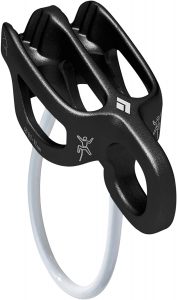
The Black Diamond ATC-Guide is the original belay device, and it’s still the best. It’s designed for sport climbing and alpine use, but it also works well for trad climbing. The ATC-Guide has a large asymmetrical surface area that distributes the force over a wide range of angles, which reduces camming action and prevents your belay loop from rotating out of position.
It has multiple friction modes for belay and rappel. Machined windows through the device for weight savings. Auto-block release hole accepts small carabiners. Durable cable holds its shape and resists getting caught up between ropes. Guide mode works with one or two climbers.
SPECS:
Item Weight: 80 Grams
Rope Compatibility: 8.1-11mm
What we like:
- Multiple friction modes for belay and rappel
- Machined windows through the device for weight savings
- Auto-block release hole accepts small carabiners
- Durable cable holds its shape and resists getting caught up between ropes
Black Diamond ATC-XP
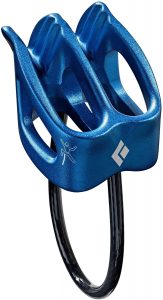
The Black Diamond ATC-XP belay device is a performance-driven belay device that combines the advantages of an assisted-braking design with the durability and versatility of a non-assisted braking design.
High-friction mode offers 3 times greater hold and stopping power than regular friction mode. Machined windows through the device for weight savings. Durable cable holds its shape and resists getting caught up between ropes. The versatile design accepts ropes from 7.7 to 11 mm.
SPECS:
Item Weight: 60 grams
Rope Compatibility: 7.7 to 11 mm.
Material: Synthetic
What we like:
- Machined windows through the device for weight savings
- Durable cable holds its shape and resists getting caught up between ropes
- Versatile design accepts ropes from 7.7 to 11 mm
- Offers 3 times greater hold and stopping power than regular friction mode.
Black Diamond ATC
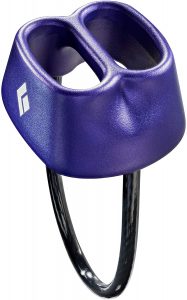
The Black Diamond ATC Belay Device is a must-have for any climber’s rack. The unique, smooth-handling geometry and minimalist design make it durable and dependable in all conditions. The large surface area dissipates heat when lowering or rappelling.
The device handles ropes from 7.7 to 11 mm, making it suitable for any application, from sports climbing to big walls. This belay device has been redesigned with a curved spine for better ergonomics and performance, as well as a new color scheme that matches the rest of the BD CAMP USA line.
SPECS:
Item Weight: 60 grams
Rope Compatibility: 7.7 to 11 mm.
Material: Synthetic
What we like:
- Unique, smooth-handling geometry.
- Minimalist design is durable in all conditions.
- A large surface area dissipates heat when lowering or rappelling.
- Handles ropes from 7.7 to 11 mm.
Trango Vergo
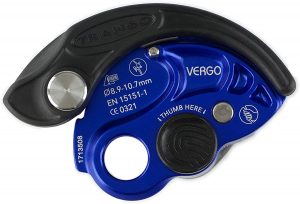
The Trango Vergo Rock Climbing Belay Device has been designed to provide the most ergonomic assisted braking device on the market. The Vergo feeds horizontally with a more natural arm motion, resulting in efficient slack management and reduced fatigue. The most comfortable way to use the Vergo is also the safest way. So you’re never tempted to override the device, even when feeding Slack.
The Vergo features physical and visual indicators reaffirming correct usage, while designated places for your thumb and index finger allow comfortable handling without interfering with the device’s braking action.
SPECS:
Item Weight: 195 grams
Rope Compatibility: 8.9 – 10.7 mm
What we like:
- The most ergonomic assisted braking device on the market, so you can use it as naturally as possible.
- Designated places for your thumb and index finger allow comfortable handling without interfering with the device’s braking action.
- The Vergo feeds horizontally with a more natural arm motion, resulting in efficient slack management and reduced fatigue.
- The most comfortable way to use the Vergo is also the safest way.
Edelrid Mega Jul
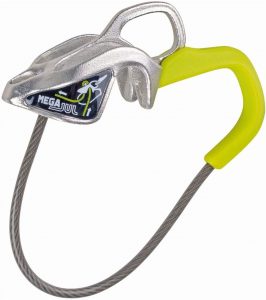
A rope is the most important piece of equipment for a climber. The Mega Jul Belay Device from Edelrid ensures that the rope is used safely and efficiently. The Mega Jul Belay Device has been designed to be used with ropes from 8mm to 11mm in diameter. It provides high braking performance, which assists the belayer with leader falls.
Robust solid stainless steel construction
The Mega Jul is made from a single piece of stainless steel, which makes it extremely robust and durable. It will not rust or wear out over time. The construction also means that there are no moving parts that can break or wear out over time.
Very lightweight construction
The Mega Jul is extremely lightweight at only 86g, which makes it easy to carry around on long routes or multi-pitch routes where weight can be an issue. This also means that your arms will not get tired after using this device for long periods.
High braking performance assists the belayer with leader falls
The Mega Jul has been designed specifically for belaying a leader or for bringing up 2 seconds on multi-pitch routes where it can often be difficult to control both strands of rope at once during belaying operations without wearing out your fingers quickly due to
SPECS:
Item Weight: 86 grams
Rope Compatibility: 7.8 – 10.5 mm
Material: Stainless steel
What we like:
- The Mega Jul Belay Device from Edelrid ensures that the rope is used safely and efficiently.
- The Mega Jul is made from a single piece of stainless steel.
- The Mega Jul is extremely lightweight at only 86g.
- The Mega Jul has been designed specifically for belaying a leader or for bringing up 2 seconds on multi-pitch routes
Wild Country Revo
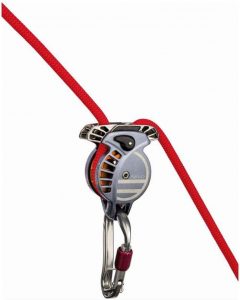
Wild Country’s Revo is a bi-directional assisted braking belay device designed to make belaying easier and safer. The Revo has a unique design, with two internal springs that provide a more consistent braking action and greater control over the rope’s descent.
The Revo has been designed to be used in both directions and works equally well for either left or right-handed users. It also features an anti-panic handle, which prevents the user from accidentally releasing the braking action by accident. This makes it ideal for beginners who are learning to use belay devices for the first time.
The Wild Country Revo Belay Device is an innovative solution for climbers looking for a simple, safe way to belay their partners on lead climbs.
SPECS:
Item Weight: 100 Grams
One Size
What we like:
- The Revo is an assisted braking device with features that contribute to your climber’s safety.
- Minimize accidents that occur from incorrectly loaded belay devices.
- Wild Country designed the Revo to be bi-directional, meaning the device works in both directions.
- It is simple for someone left-handed to use the device without having to adapt their belaying technique.
- The emergency locking function is panic-proof, and can’t be overridden by incorrect handling.
- The Revo doesn’t require any deviation from the standard belaying technique.
- With the benefit of an emergency locking feature. No special locking carabiner is required either, so you can use your favorite locker on your rack.
Petzl Reverso
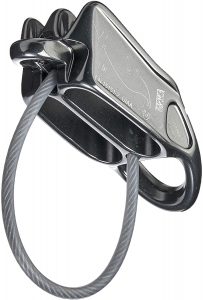
The Petzl Reverso is a lightweight, multipurpose belay/rappel device that can be used to belay a second in Reverso mode and to rappel single-handedly. It adapts to a broad range of rope diameters and offers easy handling in all situations.
The Reverso is an excellent choice for sport climbing, canyoneering, caving, ice climbing, or skiing. It was designed with an ergonomic shape that fits perfectly in your hand and makes it easy to use with any type of rope. The Reverso features a friction clutch that regulates the braking action and prevents accidental falls if you let go of the handle.
SPECS:
Item Weight: 57 Grams
Rope Compatibility: single rope 8.5 to 10.5 mm, half ropes 7.1 to 9.2 mm, and twin ropes 6.9 to 9.2 mm
Material: Aluminum
What we like:
- Multipurpose and easy to use
- Adapted to a broad range of rope diameters
- Durable and lightweight
- Comes with two types of carabiners (one auto-locking)
DMM Pivot
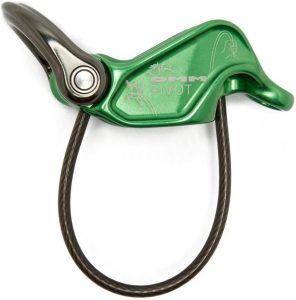
DMM pivot is a great device for the climber and belayer. The pivoting mechanism gives controlled belaying, lowering, and abseiling. The pivot enables guide mode and gives an easily controlled lowering of two seconds. High-performance internal geometry gives greater rope control. Two friction modes for varying applications.
The unique design of the pivot allows you to use 2 different braking styles depending on your preference or the type of climbing you are doing – ‘Guide’ mode or ‘Normal’ mode. Either setting will give you great rope control but Guide mode has been designed to allow easier lowering at the expense of being slightly more difficult to pull in slack when belaying a leader.
SPECS:
Item Weight: 72 grams
Size: One Size
What we like:
- Gives controlled belaying, lowering, and abseiling
- Gives easily controlled lowering of two seconds
- High-performance internal geometry gives greater rope control
- Two friction modes for varying applications
- Large surface area for better braking control
PETZL Verso Belay Device – SS21
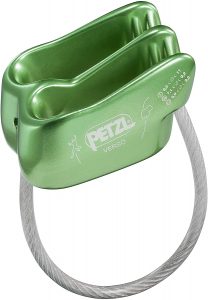
The Petzl Verso Belay Device is a great choice for all climbers, from beginners to experts. It can be used with a wide range of ropes, including single ropes, half ropes, and twin ropes.
The Verso has been designed with an innovative design that allows the climber to use both hands on the rope at all times while belaying or rappelling. This means that you won’t have to worry about having one hand on the brake side of the rope and one hand on the non-brake side of the rope like you do with traditional belay devices.
The rope slots are V-shaped so that they reduce wear and extend the life of this product. The Verso also features engraved rope insulation diagrams so that you can always make sure that you are attached properly when belaying or rappelling down. As well as being lightweight, this device is compact, making it easy to carry around all day on your climbing trips.
SPECS:
Item Weight: 55 Grams
Rope compatibility: single ropes of 8, 5 to 11 mm, half ropes of 7, 1 to 9, 2 mm, and twin ropes of 6, 9 to 9, 2 mm.
Material: aluminum frame
What we like:
- Petzl Verso Belay Device VERSO is Petzl’s lightest belay device.
- easy to use.
- Built for multi-purpose use.
- Compatible with a broad range of rope diameters.
- The Petzl Verso Belay Device can be used for both gym and crag climbing.
- The Petzl Verso uses classic belay techniques, so you’ll always have to have both hands on the rope.
- The Verso will allow the rope to glide smoothly through, so you’ll never experience tugging.
- It can be used for rappels for a more controlled descent.
- Rope insulation diagrams for belaying and rappelling have been engraved on the device to ensure you’re always attached properly.
- V-shaped friction grooves are also featured on the belay device to allow for controlled braking.
- The rounded design of the rope slots limits wear and extends the life of the device.
- The Verso is compact and ultralightweight for easy carrying.
Mad Rock Lifeguard Belay device
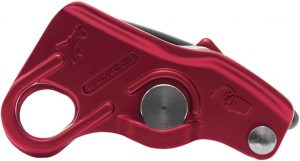
The Lifeguard belay device is compact, light, and durable. The device has been constructed using hot-forged aircraft-grade aluminum and stainless steel for increased durability. The Lifeguard can be used with classic belay techniques with single ropes ranging from 8.9mm to 11mm for lead and top-rope climbing.
The Lifeguard features a simple design that allows the user to lock off the brake strand without having to use both hands. This device is perfect for belaying multiple climbers at once because it allows you to remain in control of your partner’s fall even if they fall off route or get lost on the climb.
The Lifeguard can also be used as a rappel device when using double ropes. Using two ropes simultaneously will allow you to rappel twice as fast!
SPECS:
Item Weight: 28 Grams
Rope Compatibility: 8.9mm to 11mm
Material: Stainless Steel
What we like:
- Compact and Lightweight
- Durable Construction
- Classic Belay Techniques
Black Diamond Big Air XP Package
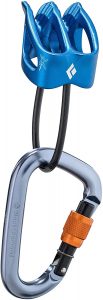
The Black Diamond Big Air XP belay/rappel device combines the advantages of wire gate carabiners with a locking carabiner for added safety. The ATC-XP is designed to belay, rappel, and ascend. It’s compact enough to toss in your pack and take on multi-pitch climbs.
The high friction mode on the ATC-XP offers three times greater hold and stopping power than the regular friction mode, which makes it ideal for big wall climbing where you may need a lot of friction to keep your partner from falling if they lose their footing or get stuck on a climb. The low-friction mode is great for top-roping where extra friction is not needed.
The ATC-XP features a built-in safety release feature that allows you to lock off the rope while ascending or descending by simply opening the device as you would normally. This release also prevents cross-loading and provides a backup should your primary belay device fail under load.
SPECS:
Item Weight: 130 Grams
Rope Compatibility: 7.7 mm to 11 mm
Material: Synthetic
What we like:
- Wiregate carabiners with a locking carabiner for added safety.
- It’s compact enough to toss in your pack and take on multi-pitch climbs.
- Offers three times greater hold and stopping power than regular friction mode.
- Features a built-in safety release feature that allows you to lock off the rope while ascending/descending by simply opening the device as you would normally.
- It prevents cross-loading and provides a backup should your primary belay device fail under load.
Petzl Red GRIGRI 3 Climbing Belay Device
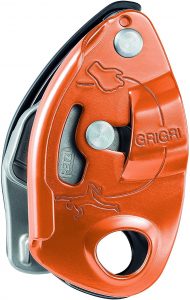
The Petzl Red GRIGRI 3 Climbing Belay Device is designed for all users, from beginners to experienced climbers. Its cam-assisted blocking function makes belaying more convenient, while its handled camming mechanism provides exceptional descent control. Feeding slack and catching falls are accomplished using standard belay techniques. Easier belaying, thanks to its cam-assisted blocking.
Rope installation diagram engraved on both the inside and outside of the device Exceptional convenience when lowering. The ergonomic handle allows you to unblock the rope and lower someone easily. Easily controlled and progressive rope feed provides smooth and comfortable descent.
The mechanical advantage of the handled camming mechanism helps control rope feed on small-diameter ropes. Simple to use for belaying both lead and top-rope climbers. Optimally balanced design. Lightweight, compact and durable. Compatible with all dynamic single ropes
SPECS:
Item Weight: 175 Grams
Rope Compatibility: 8.5 to 11 mm dynamic single ropes and optimized for those 8.9 to 10.5 mm
What we like:
- Ergonomic handle for optimum handling on lead and top-rope climbing
- Rope installation diagram engraved on both the inside and outside of the device
- Simple to use for belaying both lead and top-rope climbers
- Easily controlled and progressive rope feed provides smooth and comfortable descent
- The mechanical advantage of the handled camming mechanism helps control rope feed on small diameter ropes
- Optimally balanced design
How to Choose the Best Belay Device?
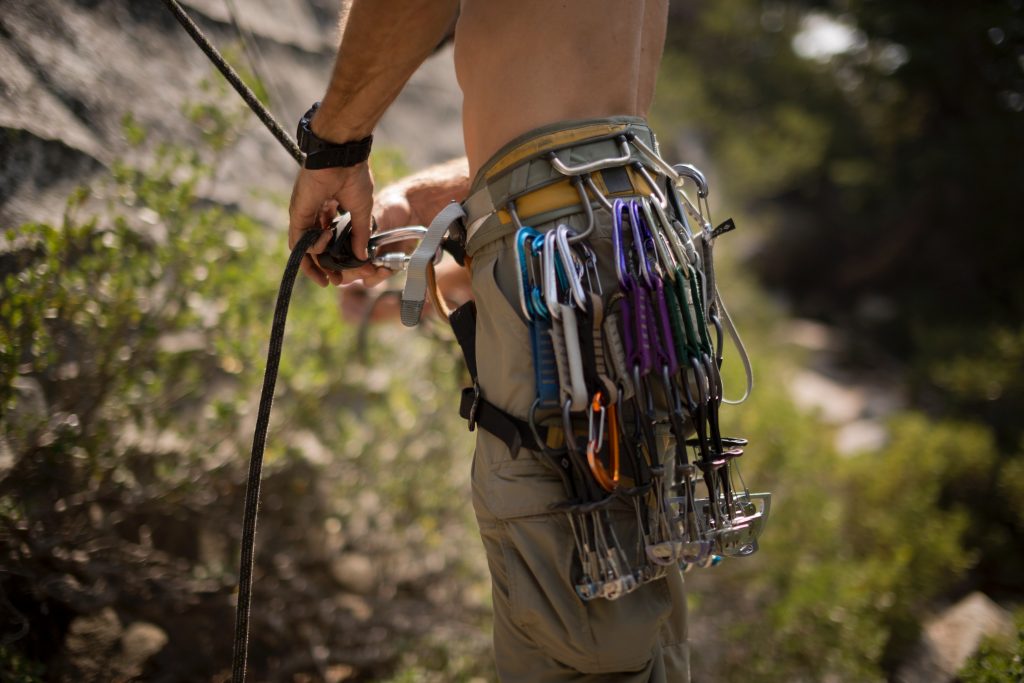
The belay device is your lifeline when you’re climbing. It’s how you manage the rope, and it’s what keeps your partner safe. The right belay device can make a huge difference in how well you climb, as well as how much fun you have.
Belay devices are the most common piece of equipment in the climbing world. A belay device attaches to the rope and provides a friction point for controlling the descent of a climber. Belay devices also have other important roles, including allowing a belayer to take in slack during rappels and lowering off of ledges. There are several types of belay devices available, each with its own advantages and disadvantages.
When choosing a belay device, it’s important to know what you need it for and how you plan on using it before committing to any one product. Here are some things to consider before buying:
1. What is a belay device and what are its uses?

Belay devices are used to control the rope when belaying a climber from the ground. They come in a variety of types, but all share the same basic function: to allow the belayer to effectively control the force of a fall and to ensure that the belayer does not receive more force than it can handle.
How do Belay Devices Work?
Belay devices work by applying friction to the rope when you pull on it. This friction slows down your descent and stops you from falling to the bottom of the pitch if you lose your footing or slip while climbing. As soon as you stop pulling on the rope, however, it will slide through your device and continue its downward path unimpeded by any additional friction being applied.
2. Belay Device styles
There are many types of belay devices on the market today, from simple tube-style devices to assisted braking devices. The type of belay device that you choose will depend on several factors.
The first factor is whether or not you plan to climb multi-pitch routes or sport climbs with fixed anchors. If you intend to climb multi-pitch routes or sport climbs with fixed anchors, then an assisted braking device like a Grigri 2 or a Reverso 4 would be ideal because they offer more versatility than a tube-style device such as a Black Diamond ATC Guide or Mammut Smart Alpine.
The second factor is whether or not you plan on climbing outdoors or indoors exclusively. If you only ever plan on climbing indoors at gyms, then there is no need to spend money on an assisted braking device like a Grigri 2 or Reverso 4 because they are more expensive than tube-style devices like an ATC Guide (Black Diamond) and Smart Alpine (Mammut).
Tube Belay Device: The Tube Belay Device is made up of a tube with an opening at both ends. It has a mechanism at one end which allows the rope to pass through it while braking it tightly. This prevents any sudden jerking while belaying. These devices can also be used as descenders by attaching them to the harness and clipping in with two carabiners.
Auto-Blocking Tube Belay Device: This type of device has a locking mechanism that automatically engages when weight is applied to the device by pulling down on it, thus preventing any sudden jerking while belaying or rappelling.
Assisted-Braking Tube Belay Device: This type of device has an assisted braking mechanism, which allows for smooth braking action when compared to other tube-style devices where you need to pull down hard on them for effective braking.
Plate Belay Device: This type of belay device operates by gripping onto the rope with two metal plates
Wire belay devices work similarly, except they have no camming mechanism, so they only work well with half-inch or thinner ropes.
3. Lowering/Rappelling/Weight and size
Lowering: This is the primary function of a belay device. The ideal device for beginners should be able to lower smoothly and slowly, which means that it has enough friction to hold the rope but not so much that it becomes difficult to move it.
Rappelling: Most devices can also be used for rappelling, but some are better suited than others for this purpose. If you plan on doing lots of rappelling and want something lightweight, look for a device with a camming trigger that can lock off the leader when descending over an edge or around an overhang (and unlock automatically when not required).
Weight and size: The lighter and smaller your device is, the easier it will be to carry it on long routes or through multiple pitches without getting in the way or dangling from your harness all day long.
4. Rope Diameter
The larger the rope diameter, the harder it is to belay. With a thicker-diameter rope, you will need to pull harder to create a larger friction surface between your device and the rope. This can cause fatigue in your arms and shoulders over time. The best belay devices are designed with a wide range of rope diameters in mind so that you don’t have to worry about changing out your device every time you switch back and forth from 10mm to 10.5mm ropes.
Rope Compatibility
If you’re climbing at an indoor gym or outdoors on single-pitch routes, then you’ll probably only need one belay device that works with both 10mm and 10.5mm ropes (or 11mm). If you’re planning on spending more time outdoors or on multi-pitch climbs where you may encounter anything from a 5.6 up to 5.12+, then consider purchasing two different devices: one for thinner ropes (10mm) and another for thicker ones (10.5mm).
Hand Positioning
Some belays require more hand positioning than others do, especially those that are rated for heavier loads or have other features such as auto-locking mechanisms that require extra attention when using them for
5. Munter hitch
The Munter Hitch is a friction hitch that can be used to belay with a single rope. It’s often used as a backup when belaying from an anchor or for situations where the climber has to self-belay on slabs or other terrain where you can’t easily create follow-through with a standard belay device.
The Munter Hitch is also a great tool for lowering since it can be used to feed out slack and lock off the rope without having to take your hand off the brake side of the rope.
The main drawback of the Munter Hitch is that it can be difficult to learn, especially if you’re new to climbing. You’ll want to practice this knot on a top rope before using it in any kind of lead scenario.
6. Multi-Pitch Belaying Devices
Multipitch belaying devices are designed to be used with a variety of ropes, from single ropes to half- and twin-ropes to full-length double ropes. They have several advantages over the single-pitch devices:
They may have more friction in the device, which means they can hold more weight before slipping. This is great for belaying heavier climbers.
They usually have a handle that rotates around, allowing you to lock them into position so you can feed slack from above as well as below your anchor, and lock back up when you need to take in slack.
They often have a locking feature that prevents the rope from moving through the device while you’re belaying. This makes it easier to feed out slack and control climber movement.
7. Auto-locking devices
These devices do not need to be unlocked by hand when lowering a climber or rappelling. Instead, they automatically lock up when released, which makes them safer and easier to use than manual belay devices such as figure eights or tube chocks. Most modern auto-locking devices also have an assisted locking mechanism that helps prevent cross-loading and reduces the amount of force needed to lock up the device in case of a fall.
Directional control
Some auto-locking devices allow you to control how much slack is fed out by flipping the lever on one side or another. This allows you to feed out more rope without having to take your hand off of your brake hand, which can be very useful when lowering someone over an edge or through a roof section.
What factors should you consider when choosing the best belay device?
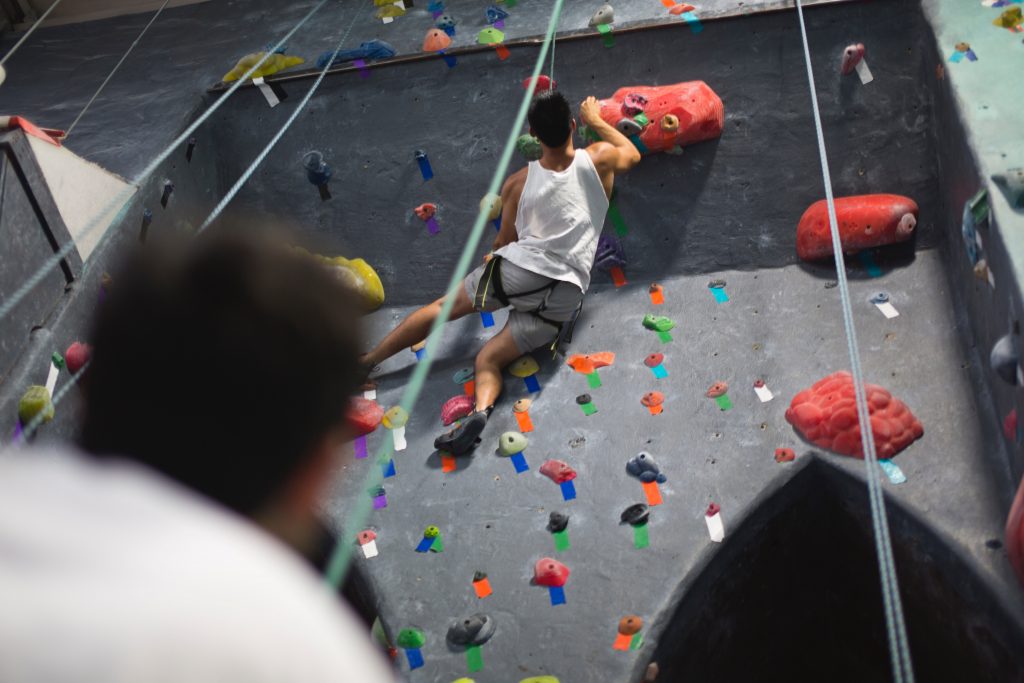
The most important factor to consider when choosing a belay device is safety. That being said, you also need to make sure that the belay device is easy to use. You don’t want to be in a situation where you are belaying someone and the belay device fails because it is too difficult to use.
Another factor to consider is the material of the belay device. You want to make sure that the belay device is made out of durable material so that it will last for a long time. You also want to make sure that the belay device is comfortable to use. If it is uncomfortable, you will not be able to use it for a long time. The last factor to consider.
General considerations for choosing the best belay device
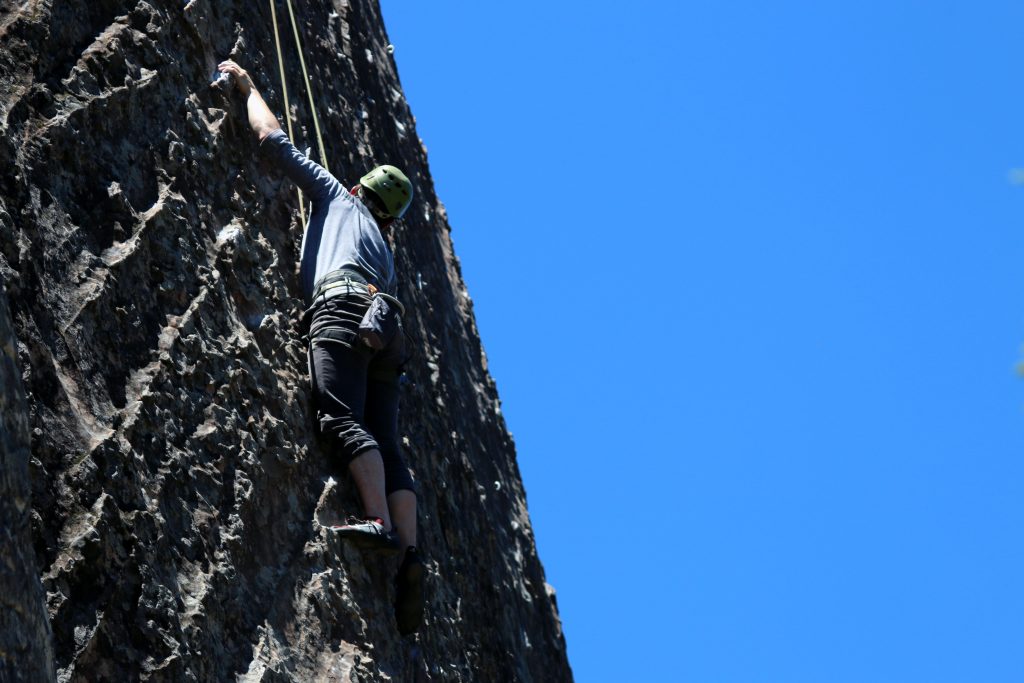
1. Figure out what you need.
Before you buy a belay device, it’s important to figure out what you need. If you want to climb indoors or outdoors at the local gym, you might prefer a simple auto-locking device that’s easy to use and inexpensive. If you plan on going climbing in the mountains or on big walls,
Then it makes sense to invest in something more advanced that can handle bigger falls and heavier weights. And if you’re just starting, then look for something lightweight and easy to use so you don’t have any problems learning how to belay with a GriGri.
The best belay devices are ones that are easy to use, are safe for all levels of climbers, and can be used for multiple applications. Here are some things to consider:
Auto-locking vs. manual locking
If you’re just starting, an auto-locking device is probably your best bet because it is easier to use and safer than a manual locking device (also known as an ATC). These devices lock automatically when weighted by your climber, so there is no chance of accidentally dropping them during their fall. However, if you want more control over how much friction is applied during their fall (for example, if they are falling
2. Where Will You Be Climbing?
The type of climbing you do will determine which belay device is right for you. If you’re climbing indoors, it doesn’t matter as much what type of device you use. You can use any standard belay device that has a locking mechanism or one that does not. For indoor climbing, go with something simple and easy to use.
If you’re going to be climbing outdoors, then there are a few more considerations to keep in mind. Most outdoor climbing areas have a specific type of belay device that they require their climbers to use. Each area has its regulations regarding belay devices, so make sure you research what’s required before heading out for your first day of climbing outdoors!
How Much Weight Can You Safely Hold?
When choosing a belay device, consider how much weight it can safely hold before failing or breaking under pressure. The weight capacity will vary depending on the type of belay device that’s being used and how much force is exerted on it while being used (i.e., how hard someone pulls down on the rope while they’re being lowered).
3. What type of climbing will you be doing?
Belay devices are designed for different types of climbing, so if you’re planning on doing something specific, then it’s important to know which belay device will work best for that activity. For instance, if you plan on climbing indoors, then a screw gate device may be better than one with a locking mechanism because they are easier to use and less likely to fail under stress when compared with their locking counterparts.
On the other hand, if you’re going to be rock climbing outdoors, then it might be worth investing in an extra durable model with an auto-locking mechanism because these devices are much more reliable than screw gate models when used under extreme conditions like high winds or heavy rainstorms.
4. Consider your experience level
The most important consideration when choosing a belay device is your experience level. The better the belay device, the more experienced you need to be to use it properly. This is because better belay devices have many more features and settings that can be adjusted, which makes them more complicated to use.
If you’re just starting out climbing or are new to using belay devices, we recommend choosing one of the simpler models that are designed for beginners. These are usually simple devices with only one or two friction settings, which makes them easier to operate and understand. They also tend to be smaller and lighter than more advanced models, which makes them easier to handle when belays are being set up on multi-pitch routes with heavy loads.
If you’re more experienced, choose something that works well with your climbing style and is light enough that it won’t slow down your progress.
5. What’s Your Budget?
When you’re buying a belay device, the first thing to consider is your budget. How much are you willing to spend?
If you’re just starting out climbing or bouldering and don’t plan on doing it very often, there are some great options for under $100. You can even find some belay devices from big-name brands that are less
You can also find some high-end models that will cost over $100! These devices are made with high-end materials and have lots of extra features that make them worth the extra money if you climb often and want a device that will last for years.
6. Your belay device should match your rope diameter.
The most common error of new climbers is not checking the rope diameter before they buy their first belay device. The wrong size can lead to multiple problems, including reduced friction and difficulty feeding slack into the system. It’s important to match your belay device with your rope diameter.
The number one rule for choosing a belay device is to make sure it matches the diameter of your climbing rope. If you have a thicker rope, you need a larger device; if you have a thinner rope, you need a smaller device. The larger or smaller device allows for more friction between the carabiner and the belay plate (the part that holds onto the rope).
7. Your belay device should be easy to use.
A belay device is a piece of equipment that you use to control the rope during rappelling or belaying. It’s an important part of your gear, so you want to make sure you choose the right one.
* Your belay device should be easy to use. If it takes too much effort or is awkward, then it can slow down your climbing and create safety concerns.
* The design should allow you to easily feed the rope through the device without getting tangled or caught on anything else nearby, especially if you’re using a tube-style device
* It should lock securely onto the rope without being too stiff, so it doesn’t take too much effort to feed the rope through it (again, this can slow down your climbing).
8. What Are Your Priorities?
The first thing you’ll need to do is decide what features are most important to you. There are several different types of belay devices on the market, each with its advantages and disadvantages. If you’re not sure which one would be best for your needs, consider these factors:
Weight: A lightweight device will make climbing easier by cutting down on excess weight from carrying too many items in your pack or on your harness. This is especially important if you plan on hiking up mountains or scrambling over rocks for long distances. Heavier models might be more durable and last longer than lighter ones over time, but they might also wear out faster if used frequently at high levels of activity or intensity.
Durability: The durability of a belay device is important because you will be using it more than once. If you don’t want to spend money on a new one every time you go climbing, it is better to choose devices that are durable enough to last a long time. Durability can be determined by looking at the materials used in making the product and how they are joined together. If the product is made from cheap materials or joined together poorly, chances are that it won’t last long enough for you to use it again and again.
9. Choose a device that does not require rethreading.
You may want to choose a device that does not require rethreading when you want to switch from rappelling to belaying or vice versa. If you’re new to climbing or rappelling, this could be important because it will make it easier for you to learn how to use the device correctly without having to worry about rethreading it correctly each time you climb or rappel.
10. V-shaped or U-shaped grooves?
The V-shaped or U-shaped grooves. These are the most common type of belay device, and they consist of two metal bars, one with a cam that grips the rope when it is pulled and the other bar, called the lever bar, which is used to control the cam. The main advantage of this type of device is its simplicity, as it does not require any special techniques. However, it can only be used on one rope at a time, and it does not work very well with dynamic ropes (ropes that stretch under tension).
Conclusion:
Fortunately, there are quite a few belay devices on the market to meet the needs of many climbers. No matter what kind of climbing you enjoy or how much money you want to spend, there is no shortage of belays for you to choose from. The best part is that they have come up with a way so that you can use them both indoors and outside. Choose wisely, and thanks for reading!





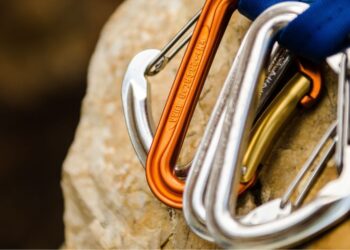




Discussion about this post